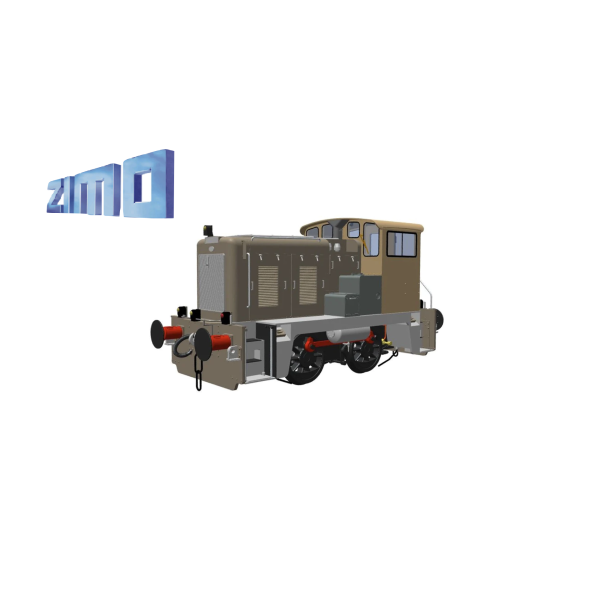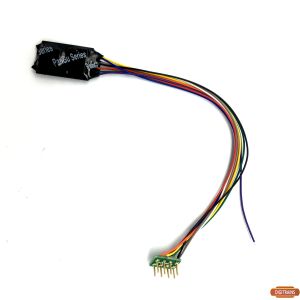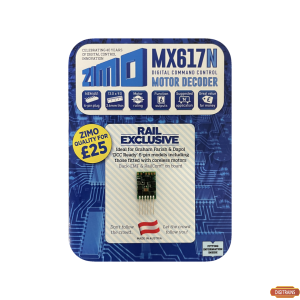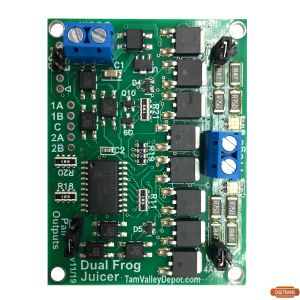Yorkshire Engine Company Half Janus & 02 ActiveDrive SL User Notes V17.07
Please spend a few moments to read these notes which have been produced so that you may obtain the maximum satisfaction from your new sound scheme.
The sounds should work perfectly when the decoder is fitted correctly. Individual locos may require some fine tuning that you can achieve with your DCC controller.
What is ActiveDrive SL?
This is a system developed to allow more prototypical sounds to be deployed across a wide range of operating conditions.
The sounds have been programmed in such a way that you, the user, may change the way that the sounds respond to your driving style or needs. This avoids the need for reprogramming and all the additional costs that would imply.
Please note that in all driving schemes listed below, small speed step increases or decreases will normally produce the best results in terms of matching sounds to loco movement.
Some of the new controls will not operate correctly if you use 14 or 28 speed steps. Please ensure you use 127/128 speed steps to get maximum advantage of these important additions.
Throttle Response Scheme.
As supplied, the decoder will produce the sounds of a YE Janus with a loaded train.
Use F1 to start up. Subsequently, the loco will stand with the diesel engine, the Prime Movers (PM), ticking over at idle.
The sounds will respond to the throttle control in the following way:
Select speed step 1. The brakes will release, the PM will increase power to get the loco moving, and will continue until at higher speed, a further ramp up will be initiated until the final high speed running sounds begin. The precise speed steps will depend upon your model, so I suggest you make a note of the actual figures for your later use.
The sounds will spool down at similar points on deceleration.
In this Version 17.07, there are extra control features to further enhance your driving pleasure.
Dynamic Inertia
A feature, unique to ZIMO, is incorporated in this version.
Open the throttle gently. The engine note will rise and fall appropriately and the acceleration will simulate that of a heavy train.
Open the throttle more widely. The engine will ramp up to full power and the rate of acceleration will be increased accordingly.
With the throttle fully opened, (then reduced if required) the loco will accelerate 3 times more quickly than normal.
Never before has a sound project simulated the variety of driving styles so accurately.
Coasting
No matter what actual speed your model is travelling at, or which engine note range is playing, reducing the throttle by 10 speed steps (of 128) will spool down the engine sounds to ‘Coasting’, whilst the loco will continue travelling with a gradually reducing speed.
The coasting sound will continue until you accelerate; at which point the sounds will change to those relevant to the current speed.
Notch Down
During any driving sound ‘loop’, at any speed, it is possible to cause the engine power to spool down to the level immediately below. This is easily achieved by reducing the speed by one step only E.g., if the loco is playing power sounds at level 5, reducing speed with your throttle by one step will cause the sound to immediately spool down to the sound of power level 4, if in level 1 power, it will spool down to idle.
Acceleration of one speed step or more will immediately ramp the sound back up to the higher power. So you can now, at any road speed, vary the engine note by reducing or adding a single speed step.
Larger downwards throttle movements (20 of 127) will cause the power to spool down to Idle.
Engine Speed Up
Need a power boost? Engage F8 to ramp up to full power, disengage to return to appropriate power sounds for throttle position.
Light Engine Mode
Activated by F5, this enables multi-function changes with one key. With small throttle increments the idle sound will be held for the first portion of driving, enabling yard movements etc without engine ramping. Alternatively, large throttle movements will produce a ramp up for a few seconds initially, after which the engine sounds will return to the level appropriate to the new speed.
This feature also automatically reduces inertia and momentum settings which you would expect of an unloaded loco, and delays automatic engine power increase ramps until higher road speeds are reached.
F5 can be operated at any speed to give another way in which the engine sounds at a given road speed may be modified instantly.
Note. This works best if you switch F5 on or off whilst the engine sounds are playing in idle. Once switched, you can leave it that way, but any further change should also be made with the engine sound again playing the idle loop. Just to be clear, the actual speed is unimportant, but the engine sound must be idling. You can achieve this in several ways as discussed above.
Speed Lock
This feature allows the road speed to be locked whilst the throttle control is used to control the engine power sounds playing.
Accurately simulating the sound of a heavy train slowly climbing a gradient with engine at full power is as easy as depicting it coasting down a gradient with the engine at Idle with this single new feature.
Here’s how it works.
Engage the SpeedLock Key, (F7) to fix the model’s road speed temporarily. The throttle now directly controls the engine sounds only. Increase speed steps to apply more power, decrease speed steps to spool the engine down to lower power bands or to Idle.
Disengage the SpeedLock Key when you wish to return control of the model’s speed to the throttle.
Working Loco Brakes
In a real locomotive, acceleration, speed and deceleration are under control of the driver. He will use his experience of the locomotive type, the train weight and knowledge of the route (or ‘Road’) to anticipate the control movements required to achieve the required performance and safety.
Deceleration is often achieved by reducing power only, allowing the locomotive to ‘coast’ to lower speeds. Typically, the brakes are only used to fine tune this rate of deceleration or make a halt at a specific point. Other times, strong braking will be required even at high speed.
A feature notably lacking in all other programmable decoder brands with UK sounds, is the ability to apply a variable braking force to increase the rate of deceleration when desired. This makes stopping a heavy train at a signal or station platform more difficult than it is on a real loco.
Without brake force, the locomotive’s dynamics are only partially modelled. There is no point in having the sound of brakes being applied if the rate of deceleration is
unaffected.
The objective is to simulate the real driving experience as closely as possible, so here’s how it works.
For optimum control and convenience, the feature needs to be assigned to a non-latching (or momentary) key. On many non-European designed DCC controllers, the only momentary key is F2. Some, like NCE PowerCab have a designated separate key which operates F key 2 from a dedicated Horn/Whistle button.
The sound project has been constructed to take these limitations into account, so the Horn/Whistle button becomes the Brake Key. (Don’t worry, the horn will not blow when you apply the brakes!).
Reduce the throttle setting to zero. The loco will coast, gradually decelerating and the engine will spool down directly to idle.
Engage Brakes with F key 2.
A short ‘dab’ will produce a short air release sound and a modest increase in deceleration rate. You can think of this as ‘Speed trimming’. This can be repeated if required, and is entirely prototypical in operation.
A longer application will produce a longer air release sound and a higher rate of deceleration.
The longer the Brake Key is held ‘on’, the greater the brake force applied
Holding the Brake Key down continuously will produce a long air release sound and the loco will perform a prototypically modelled emergency stop, i.e. Brake force increases with time; maximum brake force and deceleration rate is achieved immediately prior to coming to a halt.
Automatic brake squeal will accompany the final moments before halting.
The Brake Key can also be used to simulate ‘brake dump’ testing.
The Brake Key may also be operated during deceleration between different speeds, e.g. speed restricted areas. In this case, reduce the throttle to a suitable lower setting. The engine sound will change according to the features described earlier, so may result in a different power sound rather than engine idle. To increase the rate of deceleration, use the Brake Key as before, and the speed of the loco will be ‘trimmed’ to the newly selected speed step.
So there are no excuses available for a SPAD event.
Please note that real locos do not stop dead even during an emergency stop. To reflect this, an emergency stop will be reasonably abrupt but not sudden.
If your DCC controller is equipped with a ‘panic button’ to avert imminent catastrophe, this will still operate as usual, and will have more immediate, though less prototypical, effect than the Brake Key.
Live Volume Control
Provided the sound is switched on and the ‘fade’ button, F19, is not active, it is possible to change the overall volume to suit changing needs.
Engage F27 and the sound levels will gradually reduce, eventually to silence
Engage F28 and the sound levels will gradually increase, eventually to maximum.
In each case, disengage the F key when the desired level is attained. Set F27 and F28 as ‘momentary’ if your DCC controller allows you to do so.
Note: If the volume controls appear to not function, check that F19, F27 and F28 are disengaged before making a further attempt.
Volume Control of Individual Sounds
The volume of any sound can be adjusted to your tastes with a simple CV change. Look up the CV number in the function list below for the sound you wish to alter. Change the value to your requirements by entering a value between 1 (low) and 255 (Maximum).
Shunt Mode
For precise control when shunting, engage Shunt Mode with F21. This reduces speed by one half whilst inertia and momentum are removed completely.
It’s now down to your skill and knowledge to simulate any eventuality!
Remember. These new features may not operate correctly in 14 or 28 speed step modes. Using 128 speed step mode also allows imperceptible speed changes which nevertheless still trigger the sounds to change as described.
Paul Chetter,
Lincoln, July 2017
Function List
|
F Key
|
Function/Sound
|
Volume
Setting CV
|
|
0
|
Lights (if fitted)
|
-
|
|
1
|
Sound On/Off
|
-
|
|
2
|
Brake Key (see text)
|
517
|
|
3
|
Toot Horn
|
520
|
|
4
|
Toot Toot Horn
|
523
|
|
5
|
Light Engine
|
-
|
|
6
|
Engine Idle
|
-
|
|
7
|
Speed Lock
|
-
|
|
8
|
Engine Speed Up
|
-
|
|
9
|
Flange Squeal
|
538
|
|
10
|
Coupling
|
541
|
|
11
|
Horn (hold to extend duration)
|
544
|
|
12
|
Long Horn
|
547
|
|
13
|
Wagons Buffering
|
550
|
|
14
|
Wagons Rattling
|
553
|
|
15
|
Detonators
|
556
|
|
16
|
Compressor Dump Valve
|
559
|
|
17
|
Guard’s Whistle
|
562
|
|
18
|
Door Slam
|
565
|
|
19
|
Fade All Sounds
|
-
|
|
20
|
Function Outputs 3 and 4 (Cab Lights)
|
-
|
|
21
|
Shunt Mode
|
-
|
|
22
|
Aux 4
|
-
|
|
23
|
Reserved
|
-
|
|
24
|
Reserved
|
-
|
|
25
|
Reserved
|
-
|
|
26
|
Reserved
|
-
|
|
27
|
Volume Down
|
-
|
|
28
|
Volume Up
|
-
|





